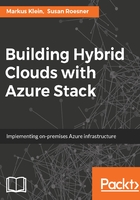
上QQ阅读APP看书,第一时间看更新
AzS-BGPNAT01
The BGPNAT01 VM provides NAT and VPN access based on the BGP routing protocol, which is the default for Azure, too. This VM does not exist in multi node deployments and is replaced by the TOR switch (TOR stands for Top of the Rack). As a tenant is able to deploy a VPN device in its Azure Stack-based cloud, and connect it to another on or off premises networking environment, all traffic goes through this VM. Compared to other designs, this VM is at the top of the rack switch and requires the following features:
- Border Gateway Protocol (BGP): This is the internet protocol for connecting autonomous systems and allows communication.
- Data Center Bridging (DCB): This is a technology for the Ethernet LAN communication protocol, especially for datacenter environments, for example, for clustering and SAN. It consists of the following subsets:
- Enhanced Transmission Selection (ETS): This provides a framework for assigning bandwidth priorities to frames.
- Priority Flow Control (PFC): This provides a link-level flow-control technology for each frame priority.
- Switch Independent Teaming (SIT): This is a teaming mode launched with Windows Server 2012. The teaming configuration will work with any Ethernet switch, even non-intelligent switches, because the operating system is responsible for the overall technology.